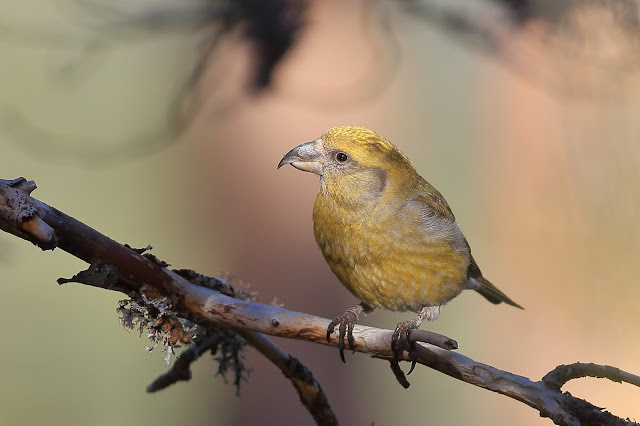Hola una vez más.
Hi again.
Hi again.
En el siguiente enlace podéis ver nuestros próximos viajes fotográficos y de observación de aves y mamíferos nacionales y al extranjero. Espero que os gusten y os animéis a venir conmigo. Una experiencia que nunca olvidareis.
In the following link you can see our next national and foreign Birds and Mammals photographic and observation trips. I hope you like them and I encourage you to come with me. An experience that you will not forget.
En esta ocasión os muestro lo que pude fotografiar en una excursión al P. N. de Guadarrama para ver tres especies que me gustan mucho y es buena época para su observación.
This time I show you what I was able to photograph on an excursion to the Guadarrama National Park to see three species that I really like and it is a good time to spot them.
Las tres especies que quería ver eran los piquituertos comunes (Loxia
curvirostra), verderón serrano (Serinus
citrinella) y mirlo acuático europeo (Cinclus cinclus).
The three species I wanted to watch were Common Crossbills, Citril Finch and White-throated
Dipper.
Sin lugar a dudas, la especie que mejor se porto y pude verla muy cercana fue el piquituerto común (Loxia curvirostra). En la foto un bonito macho.
Without a doubt, the species that behaved the best and I was able to see it very closely was the Common Crossbill. In the photo a nice male.
Una pena que no estuviese mas rojizo.
Too bad he wasn't redder.
Siempre me llama la atención la forma cruzada del pico de esta especie. Una especialización para poder extraer los piñones que son la base alimenticia de esta especie.
I am always struck by the crossed shape of the beak of this species. A specialization to be able to take out the pine nuts that are the food base of this species.
Una hembra.
A female.
Otra.
Another one.
Macho.
Male.
Este fue el macho que vi con más colorido.
This was the most colorful male I saw.
Un lejano herrerillo capuchino (Lophophanes
cristatus).
A distant Crested Tit.
Carbonero garrapinos (Periparus
ater).
Coal Tit.
Vi varios petirrojos europeos (Erithacus
rubecula) pero ninguno quiso que me acercase mucho.
I saw several European Robins but none allowed me to get too close.
Me costó bastante encontrar a los verderones serranos (Serinus
citrinella). En la foto un macho.
I had a hard time finding the Citril
Finch. In the photo a male.
Otro.
Another one.
Una hembra.
A female.
Como es habitual, había bastantes cornejas negras (Corvus
corone).
As usual, there were quite a few Carrion Crows.
Un macho de escribano montesino (Emberiza
cia).
A Rock Bunting male.
Que bonitos son.
They are very pretty.
Buitre leonado (Gyps
fulvus).
Griffon
Vulture.
Vi mas buitres negros (Aegypius
monachus) que leonados (Gyps
fulvus).
I saw more Black Vultures than Griffon Vultures.
Una bonita lavandera blanca (Motacilla
alba).
A beautiful White
Wagtail.
En esta ocasión los mirlos acuáticos europeos (Cinclus cinclus) estaban muy asustadizos y mantenían mucha distancia.
On this occasion the White-throated
Dipper were very skittish and kept a long distance.
En el tramo de río que recorrí, al menos había cuatro ejemplares.
In the stretch of river that I walked, there were at least four specimens.
Para acabar el día decidí bajarme hasta el embalse de Santillana y sus alrededores. Había algunos zorzales alirrojos (Turdus iliacus).
To end the day I decided to go down to the Santillana reservoir and its surroundings. There were some Redwing.
Trepador azul (Sitta europaea).
European
Nuthatch.
Me encanta el color de las plumas que tienen debajo de la cola.
I love the color of the feathers under their tails.
Herrerillo común (Cyanistes
caeruleus).
Blue Tit.
Los pico picapinos (Dendrocopos
major) estaban tamborileando.
Great spotted woodpeckers were drumming.
Al igual que los picos menores (Dryobates
minor). En la foto un macho pues como veis tiene el píleo rojo. Las hembras lo tienen negro.
As same as the Lesser Spotted
Woodpecker. In the photo a male, as you can see, has a red cap. Females have it black.
Había muchísimas gaviotas sombrías (Larus fuscus) y reidoras (Chroicocephalus
ridibundus).
There were plenty Lesser
Black-backed Gulls and Black-headed
Gulls.
Al atardecer llegaron varios bandos de tarros canelo (Tadorna
ferruginea).
At dusk several flocks of Ruddy
Shelduck arrived.
Llegue a contar 31 especímenes.
In the end I counted 31 specimens.
Había varias parejas de cucharas comunes (Spatula
clypeata). En la foto un macho.
There were several pairs of Northern
Shoveler. In the photo a male.
Y también de ánades frisos (Anas
strepera). En la foto otro macho.
And also Gadwall. In the photo another male.
Un alcaudón real (Lanius
meridionalis).
A Southern
Grey Shrike.
Esta garceta grande (Egretta
alba) tenia una pata rota. Que pena.
This Great
White Egret had a broken leg. What a pity.
Entre los gansos del Nilo (Alopochen
aegyptiaca) había uno que tenía una mutación de color. Muy bonito por cierto.
Among Egyptian Geese there was one that had a color mutation. Very pretty by the way.
Es el segundo adulto que veo con esta mutación de color en estado salvaje.
This is the second adult I have seen with this color mutation in the wild.
Y con esta foto de un bonito macho, me despido de todos vosotros hasta el siguiente blog.
And with this photo of a beautiful male, I say goodbye to all of you until next post.
Si queréis suscribiros a este blog de los viajes que hacemos pincha en el siguiente enlace: Suscribirse y haz clic en ¿Quieres suscribirte a nuestro blog?
If you want to subscribe to this post about the trips we do, click on the following link: Susbcribe and click on: Do you want to subscribe to our blog?
Espero que os haya gustado y hasta pronto.
I hope you like it and see you soon.


























































































































































































